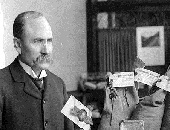Standing at the Precipice?
What is shadow banking, and are the associated risks being properly mitigated? A summary of issues can be found in the webinar “Shadow Banking: Standing at the Precipice?” sponsored by the Global Association of Risk Professionals (GARP) on August 6, 2019. Fabio Natalucci, Deputy Director, Monetary and Capital Markets Department of the International Monetary Fund (IMF), was the first of two speakers at the one-hour webinar. He began by explaining that the shadow banking system prefers to be thought of in “less sinister” terms as “non-bank financial intermediaries” that provide services similar to, but outside of, the regular banking system. He described […]
Missing the Mark
“In the spring a young man’s fancy lightly turns to thoughts of buying a house,” Morty said, as he put the latest issue of the Financial Analysts Journal on my desk. We don’t often paraphrase Tennyson in the office, so this caught my attention. “You’re not thinking of moving again, are you?” I said. “No, but I always keep my eye on the market,” he said. “You should check out what these economists are saying.” So I did. First I read the FHFA working paper, by the team of Alexander Bogin, William Doerner, and William Larson. “Missing the Mark: Mortgage […]
As Fast as You Can
The implementation window for the new Current Expected Credit Loss (CECL) standard may seem plenty big enough, but there are loads of decisions to be made, such as “how will we calculate this?” “Decide on methodology and start implementing as fast as you can,” advised Masha Muzyka, Senior Director, Regulatory and Accounting Solutions at Moody’s Analytics. She was part of a round-table discussion, held on January 10, 2018, about the transition to CECL. The webcast was organized by the Global Association of Risk Professionals (GARP). The new CECL standard will bring significant changes, such as a spike in earnings volatility. […]
Challenges to modelling
Constructing an accurate financial model for the Current Expected Credit Loss (CECL) may present problems to some banks. Possibly a bank is collecting data for annualized charge-off rates. However, that would overlook the question: “how would that inform someone as to the loss rate over the lifetime of the portfolio?” asked Michael Gullette, SVP, Tax and Accounting at the American Bankers Association. The question boils down to whether a bank has enough data of the right kind to see trends and relationships. “And if you have the data, what is the quality?” Gullette said. He was part of a round-table discussion […]
Never too early to start
The “reasonable and supportable” clause of the new Current Expected Credit Loss (CECL) standard “is the most hotly debated part” of the regulation, according to Cristian deRitis, Senior Director, Consumer Credit Analytics at Moody’s Analytics. He was part of a round-table discussion about the transition to CECL that was webcast by the Global Association of Risk Professionals (GARP) on January 10, 2018. CECL is the new credit impairment standard under Financial Accounting Standards Board (FASB). “Auditors are grappling with what ‘reasonable and supportable’ means, too,” he added. For best practice in terms of modelling credit risk, the phrase boils down to whether […]
Pain of Payment for … the First Date
This concludes the interview with Professor Avni Shah regarding consumer behaviour and the connection we feel to the stuff we buy. And, possibly, to the people we buy it for. Click here to read the first half of the interview. Q: Did you look at other aspects of the connection? I said, let’s see how long this effect persists. I got data for the years 2004 to 2013 from an alumni association. What I was interested in is how alums make donations: by cheque versus card. Cheque feels more painful because you have to write out that amount. I wondered […]
Pain of Payment for … Coffee
“Me? Why do I have to pay for the falafels? I barely have two dollars to rub together,” said Morty. Tuesday is the two-for-one special at our local take-out Mediterranean shop. “Take it from me—you’ll enjoy them more!” I said, tapping the article I had just been reading in the New York Times. In a nutshell, it reported on new research in the Journal of Consumer Research that said having some difficulty in payment increased the consumer’s connection with the item purchased. He grabbed the section to read while we wolfed down our falafels. “You’ve gotta interview these people,” he […]
“The Death of the Soul”
Do you long for the good old days? What, exactly, were “the good old days”? Depends on your time horizon. Today’s excerpt comes from page 11 of Economic Thought: A Brief History by Heinz D. Kurz, translated by Jeremiah Riemer (Columbia University Press, 2016). “According to Scholastic economic thought, the answer to the material hardship experienced by large segments of the [medieval European] population was not higher production and economic growth but self-restraint and the repression of needs. “The heart of Scholasticism was the doctrine concerning usury. A core argument was that money is sterile—it cannot “breed offspring.” Another argument […]
“Worse Than Silverfish”
Some authors go to great lengths to make their monographs up-to-the-moment. In this excerpt, the authors refer to a popular and critically acclaimed TV series. It’s a calculated risk. They use an obsession of the (fictional) characters—the money they are amassing—to tie into the very real phenomenon of hyperinflation. Today’s excerpt comes from page 103 of the book The Evolution of Money by David Orrell and Roman Chlupaty (Columbia University Press, 2016). “To visualize how hyperinflation can affect one’s personal savings, fans of the TV show Breaking Bad will recall the episode in season 5 in which it is shown […]
War, Kidnapping, Data Theft
War, kidnapping, and data theft: Is it some fiction pot-boiler that’s come over the transom? No, it’s the chapter on how the gross domestic product (GDP) came into being in Germany. Today’s excerpt comes from pages 117-8 of the book The Power of a Single Number: A Political History of GDP by Philipp Lepenies, translated by Jeremy Gaines (Columbia University Press, 2016). “[John Kenneth] Galbraith was surprised by the results of his calculations and surveys because they, for the first time, provided a clear picture of the Nazi economy. Because no set of tools comparable to gross national product calculation existed on […]










